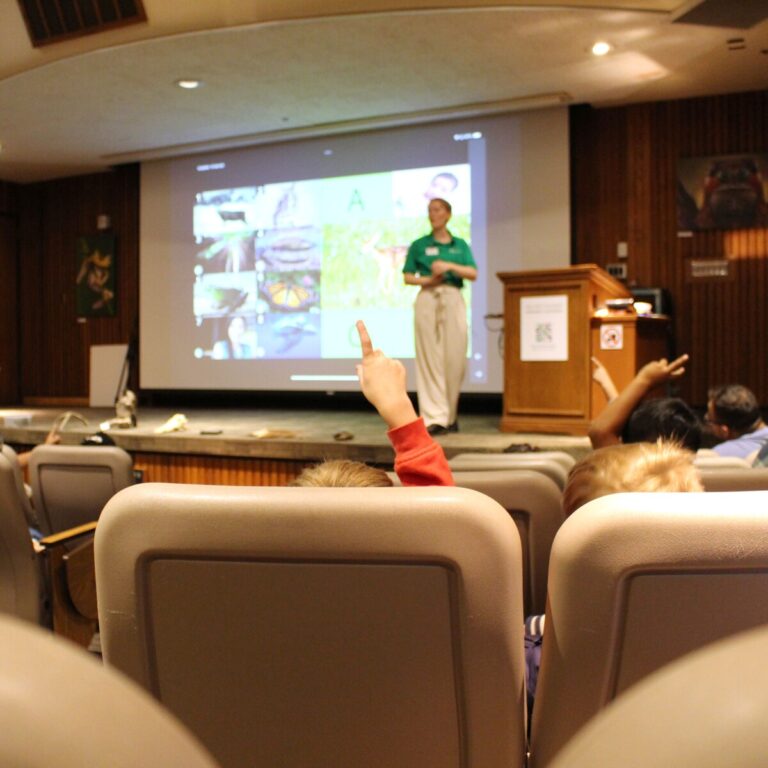Students participate in the program by holding up their fingers and answering questions. The auditorium is used to host school and community programs. (Grace Eyestone)
Monte L. Bean Museum of Life Sciences student educators offer guided tours for elementary school students and the community.
The museum’s mission is to “inspire wonder, understanding, and respect for our evolving planet,” according to its website.
The museum offers nine different school programs designed for specific grade levels, related to the Utah Science Core Curriculum, according to its website. Each program includes an interactive presentation by one of our student educators and corresponds to the curriculum being taught that year.
McKenna McLaws, a first-grade teacher at Parkside Elementary School, took her students to the Bean Museum for a program about family patterns in nature. This is what her students are learning this year.
“In our class, we talk about parents and offspring, similarities and differences in their life cycles, and protective behaviors,” she said. “So according to our standards, everything went well.”
The presentation included videos, matching games and an appearance by Rosie, one of the museum’s live Chilean rose-haired tarantulas. Children participated by selecting videos, answering questions, and discussing with their neighbors.
“They do a great job with the presentations and videos and getting the kids involved,” said Debbie Smith, one of the teacher’s assistants at Parkside Group.
Leah Oberle, a student educator at the museum, guides children about the differences and similarities between parents and children, which first-graders are learning in class.
“Seeing what you’re learning in action makes a difference,” she said. “I think structured presentations with specimens, videos, etc., or just going to a museum and seeing things in person, can help you remember things.”
Students interact with real specimens as part of the program. Students were able to touch duck and crocodile skulls and horns and turtle shells. (Grace Eyestone)
At the end of the presentation, the children were able to touch and interact with some of the museum’s specimens, including an alligator skull, a turtle shell, and a real stuffed duck. Afterwards, they had time to explore the museum and see the animal exhibits.
“What we have to offer that is different from what others are offering is specimens,” Ober said.
The Bean Museum houses more than 3 million specimens, ranging from giraffes to beetles to hippos and plants. Many of these specimens are in research collections, but there are more than 2,000 specimens available to teachers in the educational collection, said Katie Knight, museum education director.
All programs offer interaction with specimens, and schools can access the programs in a variety of formats, including in-house, outreach, and webcast. All of these programs aim to make the curriculum more accessible to students by providing interaction with subject materials and specimens.
Specimens can also be loaned to teachers and schools for classroom use.
“Getting kids interested in science is what we’re trying to do,” Knight said. “If they can feel that sense of wonder, awe and curiosity and start exploring themselves, we hope that we can inspire the next generation of scientists to carry on this work.”
The museum also hosts other educational programs and events available to community members, families, and students. Free programs include family home evening events and community programs that the museum offers to help people understand and appreciate the world, Knight said.
“The ultimate goal is obviously to protect and take care of the planet,” Knight said. “Once you start learning more about it, you start caring about it, and then you start valuing it.”
The children crowded around Rosie the Tarantula to get a closer look. The Bean Museum has several living specimens on display. (Grace Eyestone)
Source link


